Table of Contents
If you’ve never flown into Majorca’s Palma airport before, you may find the size of the place quite breathtaking.
From its very humble beginnings in the early days of the package (or to quote its official title ‘inclusive’) tour, the airport at Palma has been in an almost constant state of expansion.
Palma de Mallorca Airport, also known as Son Sant Joan Airport, has become one of Spain’s busiest airports and a major gateway for tourists visiting the beautiful Balearic island of Mallorca.
Located just 8km east of Palma, the island’s capital, the airport handled over 29 million passengers in 2019 before the Covid-19 pandemic. It currently ranks as Spain’s third busiest airport after Madrid-Barajas and Barcelona-El Prat.
Terminal Building

Unlike many UK airports which have two or more terminal buildings, Palma airport for all its size only has one!
Once off the aircraft, you may have to walk a fair distance to be reunited with your luggage.
This is especially true for most UK flights, as they arrive at a new part of the building on the other side of the airport.
It is at least a 10 to 15-minute hike to the luggage reclaim hall.
The long walk does have an upside though as there are plenty of moving walkways & you pass by many of the bars, food outlets and shops which you can remember when you are waiting for your return flight.
Palma airport may be a daunting size, but the facilities on offer are excellent. I have always found the workings of the airport efficient and the staff friendly.
Passenger Facilities and Services
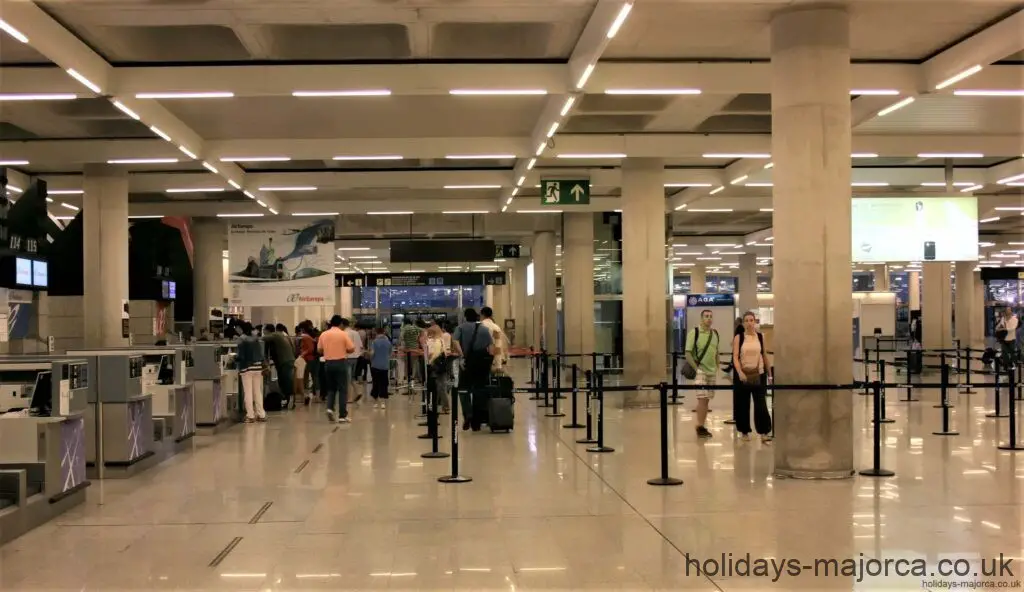
Palma de Mallorca Airport provides a modern passenger experience in line with its position as one of Europe’s leading travel hubs. Here is an overview of some of the key facilities and services on offer:
Check-In Areas
There are 178 check-in desks located on the upper departure level of the main terminal building adjacent to the main entrances.
Automated self-service kiosks are also available to passengers needing to check in and print boarding passes. The check-in areas feature flight information screens and are divided up by airline.
Security & Passport Control
Once checked in, passengers pass through centralised security screening before accessing the various modules to reach their departure gates.
Further passport control and customs checks are conducted at the gates for flights outside the Schengen Area.
The airport has implemented advanced systems for screening luggage as well as the latest biometric and automated gates to help expedite processing of passengers.
The EU Schengen Agreement allows travellers from one EU member state to pass through other members’ borders without passport restrictions.
As the UK is no longer a member of the EU & was not a participant in the Schengen Agreement, all UK flight arrivals to Palma airport are now received at a separate gate to the likes of Germany, France, Belgium, etc.
The gates used by UK flights still have passport control posts, so make sure you have your passport ready when arriving or leaving Majorca!
Unfortunately, the queues can get quite long, as there seems to be a much more thorough check performed on passports than was done previous to the Schengen agreement coming into force in Spain.
At the time of writing, gate D was being used for flights from the UK to Palma airport.
Shopping and Dining Options
The airport offers an extensive range of duty-free and other retail outlets on both the public and restricted areas spanning some 5,000 square metres in total.
This includes specialist tobacco and liquor stores in Modules A and D as well as over 30 cafes, restaurants and bars throughout the various modules. Major global brands like Ralph Lauren, Hugo Boss, Bulgari and Hermes are present.
Free wireless internet access is available throughout the terminal buildings. Other amenities include bank/ATM services, postal services, medical assistance and dedicated prayer rooms.
Gate Assignments and Wayfinding
The airport has implemented clear wayfinding signage in multiple languages to direct passengers. Flight information display screens are ubiquitous throughout the terminal.
Gates are divided between the four modules – A, B, C and D. Passengers go through a centralised security zone first before accessing their assigned module and gate. Those unfamiliar with their gate assignment can easily discover it from one of the many flight information screens.
Ground Transportation
Taxis and rideshare services are available at designated stations outside the arrivals area on the lower ground floor.
Rental car agencies also have desks here along with public bus stops connecting to central Palma.
A taxi rank marshalling area helps organise taxis and prevent long queues from forming. There are also direct private transfer services to area hotels and resorts available.
History of Aviation in Mallorca
The origins of aviation in Mallorca can be traced back to the early 1920s when the Spanish government first examined establishing an airmail service to the Balearic Islands using seaplanes.
Before there was a dedicated airport, test flights were conducted in the areas of Son Sant Joan and Son Bonet, where basic landing strips were prepared.
In 1934, a small private company called Aero-Taxi de Mallorca was set up offering tourist flights to the island. This operated out of the existing Son Sant Joan airfield.
By 1935 scheduled flights began between Mallorca and mainland Spain operated by LAPE (Líneas Aéreas Postales Españolas), the forerunner of Iberia Airlines. At this stage, civilian flights were concentrated at the alternative airfield at Son Bonet whilst Son Sant Joan was predominantly used by the military.
Transforming Son Sant Joan into Palma’s Commercial Airport
Rising demand coupled with limitations on expanding Son Bonet led planners in the late 1950s to propose developing Son Sant Joan into a civilian airport to serve the booming tourism industry.
Son Sant Joan Airport was officially opened to domestic and international traffic on 7 July 1960. Just two weeks later expansion was declared urgent with work soon beginning to extend the runway and build new facilities.
A second smaller terminal (today’s Terminal B) opened in 1972 to handle non-scheduled flights. By 1974 a second parallel runway was complete.
Further major expansion of terminals and infrastructure took place from 1993 to 1997 including the opening of the current main terminal building designed by Majorcan architect Pere Nicolau Bover.
Entering the 21st Century
Passenger traffic at Palma Airport exceeded 15 million per year by the mid-1990s and went on to peak at 29.7 million in 2019. Today it handles flights predominantly from Germany, mainland Spain and Great Britain with Air Europa, Eurowings, EasyJet, Jet2 and Ryanair amongst the major airlines operating there.
The airport occupies a vast site of 630 hectares with four modules – A, B, C and D. Following a major renovation project from 2009-2011, Module C now stands as the largest with 33 gates connected by airbridges.
Module D handles many flights within the Schengen Zone while Module A is reserved more for non-Schengen destinations.
In recent years, significant investments have been made in new equipment and technologies to enhance services and efficiency. After being bestowed with the prestigious Airport Service Quality Award in 2012, Palma de Mallorca Airport seems well poised to maintain its position as a leading European hub for the foreseeable future.
Timeline of Key Developments
- 1921 – First seaplane airmail service flown between Barcelona and Palma
- 1934 – Aero-Taxi de Mallorca formed offering tourist flights
- 1935 – Scheduled flights commence between the Spanish mainland and Mallorca
- 1960 – Son Sant Joan Airport officially opens for civil aviation
- 1965 – Construction of original Terminal A building
- 1974 – Second runway completed
- 1993-1997 – Major expansion including today’s main terminal building
- 2009-2011 – Refurbishment and capacity upgrade of Module C
- 2012 – Wins Airport Service Quality Award from industry body ACI
Behind the Scenes – Operations and Administration
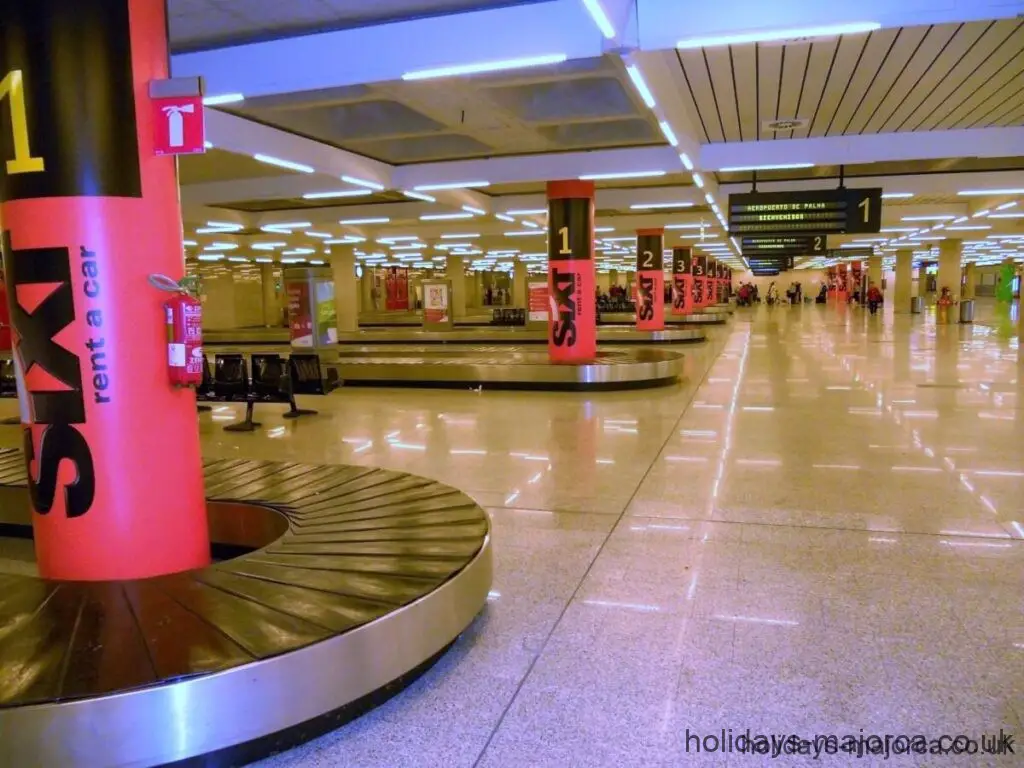
As one of Spain’s largest airports, Palma de Mallorca functions as a small city in terms of operations and administration. Here is an overview of some of the key statistics and infrastructure involved in keeping it running smoothly:
Ownership and Management
The airport is operated by Aeropuertos Españoles y Navegación Aérea (AENA), the Spanish airport authority responsible for most of the country’s civil aviation infrastructure.
As a state-owned company, AENA coordinates very closely with national aviation regulators and agencies as well as regional Balearic authorities.
Usage Statistics
During peak summer months, the airport handles over 1,000 flight movements per day making it the third busiest airport in Spain on this metric.
The two parallel runways provide significant flexibility to handle this very intensive schedule. In a typical year, the airport registers around 30 million passengers, 220,000 aircraft movements and 7,500 tonnes of cargo.
Infrastructure and Facilities
Behind the scenes, the airport occupies a total area of 6.3 square kilometres. Supporting the terminals and runways is an extensive array of infrastructure and facilities:
- Power plant
- Fire and rescue station
- Police and security facilities
- Control tower and navigation aids
- Aircraft maintenance hangars
- Cargo storage and handling areas
- Support vehicle depots
- Administration buildings
The airport has backup generators, firefighting equipment, snow-clearing gear (not often needed), and other contingency resources to deal with emergencies and ensure continuity of operations.
Recent Investments and Upgrades
Between 2007 and 2011, over 75 million Euros were invested to expand capacity. This included new taxiways and aprons along with renovating the terminals.
Baggage handling, passenger boarding bridges, washrooms, WiFi coverage and accessibility facilities were all upgraded significantly.
Ongoing investments have been made more recently in new security screening technologies, self-service kiosks, fire suppression systems, parking management tools, and IT infrastructure. Further upgrades are planned going forward.
Passenger Impressions
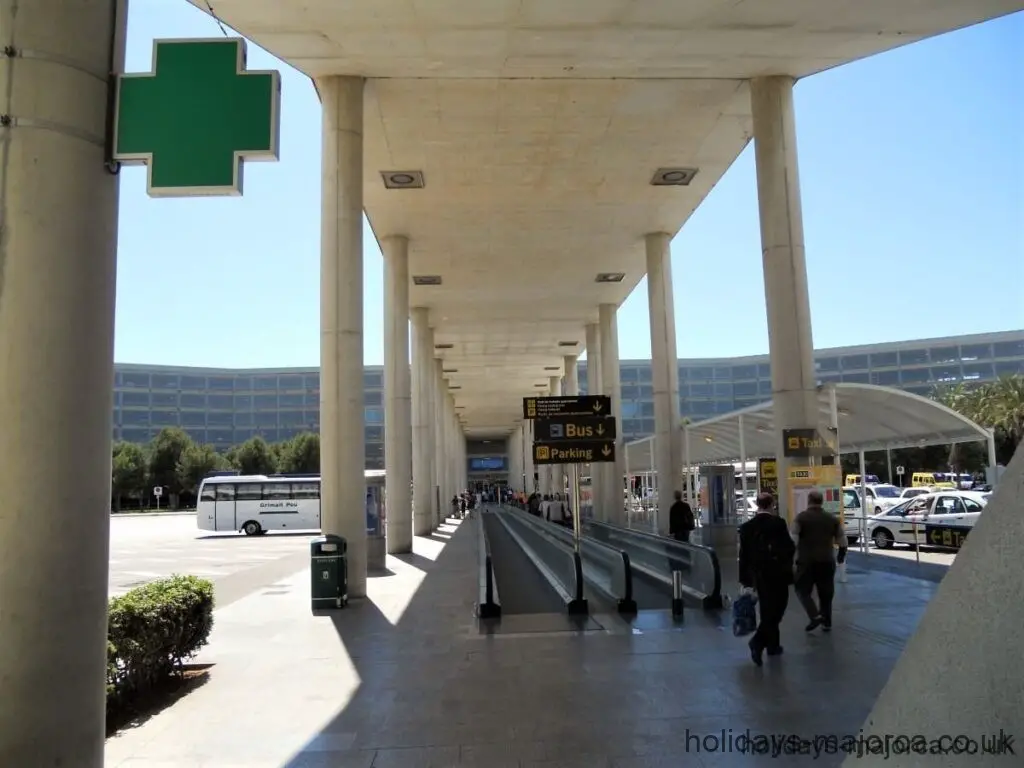
As a gateway for over 30 million travellers each year, passenger experiences and impressions offer valuable insights into the services and facilities at Palma de Mallorca Airport.
Some themes that commonly emerge from traveller reviews include:
Efficient Processing and Friendly Staff
Many travellers commented positively on the speed of processing through check-in and security along with the friendliness and helpfulness of airport staff.
The centralised security screening coupled with extensive wayfinding signage makes navigating the expansive terminal buildings reasonably straightforward according to passenger accounts.
Abundant Amenities
A large majority of reviewers highlighted the abundant food/beverage options and shopping selections once through security. With over 30 dining establishments and 50 retail outlets, the airport seems well-equipped to handle the high passenger volumes. The free wireless internet also earned praise as a useful amenity.
Access and Transport Links
The convenience of rental car facilities and taxi/shuttle bus connections right at the terminal exits received positive feedback from travellers.
Some noted that better public transit options to Palma itself would be beneficial but rated the overall transport connectivity highly.
Comfortable Waiting Areas
Reviewers noted Terminal C in particular offered generous seating arrangements along with charging points for devices allowing comfortable waits at the departure gates. A few commented on warmth within the terminal buildings during peak summer travel periods.
Cleanliness and Organization
The airport earned praise for clean washrooms, floors and seating areas. Many cited the clear organisational layout and wayfinding as helpful when navigating between check-in, security and the various modules even with very sizeable crowds.
While no airport seems immune from criticism, Palma de Mallorca received largely positive passenger commentary as an efficient, welcoming and well-appointed transport gateway to Mallorca.
Continued vigilance and investments by the managing authorities help secure this reputation going forward.
Palma Airport Arrival and Departure Information
You can get up to the minute details of flight cancellations, departures and arrivals to Palma airport below:
Click here for the latest flight information
Do you have any further information about Palma airport that you would like to add?
If so, please use the comments feature below.
Palma de Mallorca Average Flight Duration
Majorca Airport FAQ
Majorca has one international airport located on the outskirts of the island’s capital, Palma de Mallorca.
However, there are also a few private airfields for small aircraft dotted around the island.
No, Majorca (Mallorca) only has one main commercial airport, Palma de Mallorca Airport (also known as Son Sant Joan Airport). There used to be a smaller airport called Son Bonet that handled some civilian flights, but Palma Airport is now the island’s sole passenger airport.
It is recommended to arrive at Palma Airport 2-3 hours before your flight departure time, especially during peak summer travel seasons. This allows enough time to check-in, get through security, and navigate the large terminal buildings to your gate.
Yes, Palma de Mallorca Airport is very large, spanning over 630 hectares in total area. It can handle over 30 million passengers annually and has one main terminal building with 4 modules (A, B, C and D).
As Spain’s third busiest airport, Palma de Mallorca Airport gets very busy, especially during summertime. It can handle over 1,000 flight movements per day in peak season. The two parallel runways help manage high traffic volumes.
Palma Airport has undergone continuous expansion since the 1960s to meet rising passenger demand from holiday travellers headed to Mallorca. Additional terminals, runways and infrastructure have been added periodically. Recent upgrades increased capacity to over 30 million passengers annually.
Palma Airport has one large main terminal building which is divided into 4 modules labelled A, B, C and D. The modules are interconnected but host departure gates for various airline alliances and destinations.
The closest town to Palma Airport is Palma itself, the island capital, which lies just 8 km west of the airport location. Son Sant Joan suburb where the airport is situated is sparsely populated.
Palma Old Town is approximately 10 km or 6 miles from Palma de Mallorca Airport. By taxi or rental car, the drive takes 15 to 20 minutes depending on traffic conditions. Public buses also connect the airport with Plaça d’Espanya in central Palma.
Majorca’s airport is called Son Sant Joan Airport.
Son Sant Joan refers to the name of the area the airport is located in.
The holiday resorts of Ca’n Pastilla, Ses Cadenes & S’Arenal are located close to Majorca’s airport.
Majorca’s Son Sant Joan International Airport is located to the southeast of Palma de Mallorca.
The map below gives the exact location.
Click to show map!

Mark Kaye is a travel writer and content creator living in Majorca, Spain. Originally from the UK, Mark moved to the island and quickly fell in love with Majorcan culture, food, and scenic landscapes. When he’s not busy writing detailed guides about Majorca’s top tourist attractions and hidden local gems, you can find him out exploring coastal trails or wandering the streets of Palma’s Old Town in search of his next great restaurant discovery.
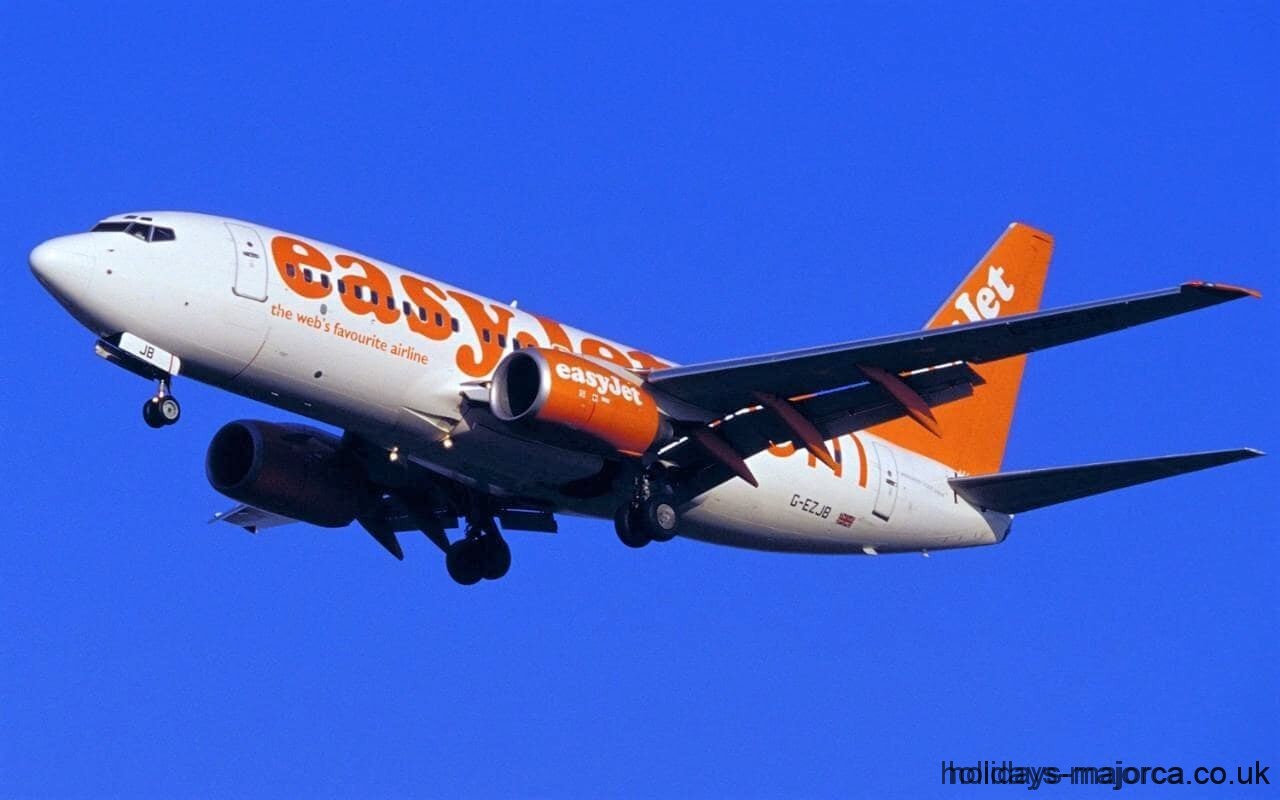


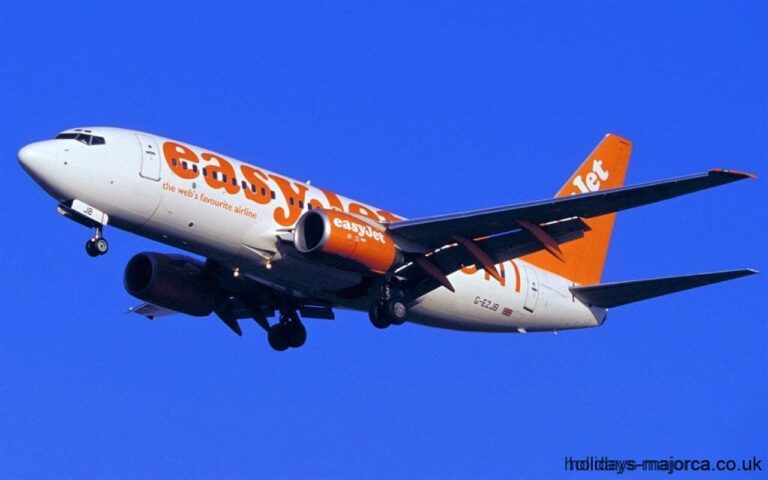

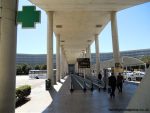



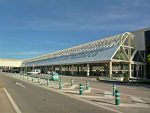



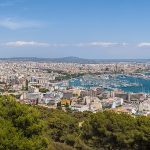



I Think There Should be a Brand New Railway Station at Palma Airport in the future. Not only that. I Think There Should be a Brand New Direct Train Service from Palma Airport to Calas de Mallorca in the future as well.